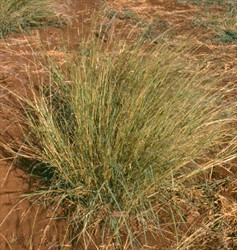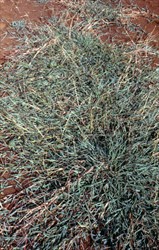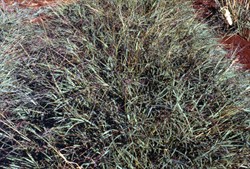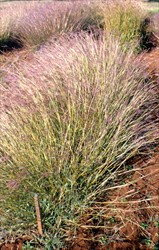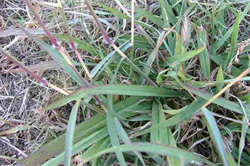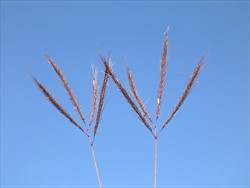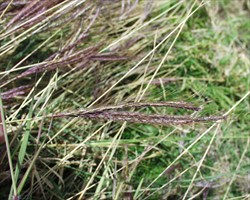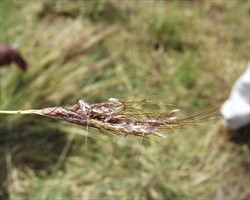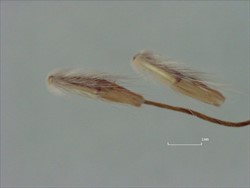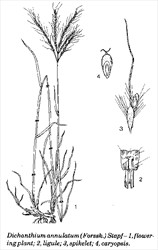Dichanthium annulatum
Tropical Forages
Dichanthium annulatum (Forssk.) Stapf
Subordinate taxa:
Dichanthium annulatum (Forssk.) Stapf var. annulatum
Dichanthium annulatum (Forssk.) Stapf var. papillosum (Hochst. ex A. Rich.) de Wet & J.R. Harlan
var. annulatum: Basionym: Andropogon annulatus Forssk.; Dichanthium nodosum Willemet
var. papillosum: Basionym: Andropogon papillosus Hochst. ex A. Rich.; Dichanthium papillosum (Hochst. ex A. Rich.) Stapf
Family: Poaceae (alt. Gramineae) subfamily: Panicoideae tribe: Andropogoneae subtribe: Anthristiriinae.
Perennial tussock with short rhizomes, sometimes stoloniferous; surface rooted (>90% of roots in top 1 m soil); tillers geniculately ascending to 80 cm and culms to about 1 m (rarely 1.8 m); nodes with pronounced annulus of radiating, 3‒5 mm long white hairs. Leaf sheath lax, terete, 3‒4 cm long, glabrous except finely pubescent on margins near throat; ligule membranous, to 4 mm long; leaf blade linear, to about 30 cm long and 2‒7 mm wide, margins slightly thickened, sparsely pubescent, scaberulous. Inflorescence a sub-digitate panicle, comprising (1‒) 2‒9 (‒15) pale green or purplish racemes, each 3‒7 cm long; peduncles glabrous; awn geniculate, twisted, 8‒25 mm long arising from the upper lemma of the sessile spikelet. Caryopsis oblong to obovate, dorsally compressed, ca. 2 mm long (1.9 million/kg); seed units (sessile + pedicellate spikelet) about 500,000/kg.
Four ecotypes have been described based on distribution and plant morphology (plant structure, raceme length and thickness, and hairiness characteristics of the lower glume of the sessile spikelet: 'Tropical' (moderately robust, decumbent with thick racemes; the glumes are broad, blunt and conspicuously covered with long bulbous-based hairs); 'South African' (var. papillosum; large, erect, robust plant with very broad racemes; glumes blunt and equipped with a conspicuous fringe of long, bulbous-based hairs); 'Mediterranean/Desert' (erect, fine stemmed with narrow racemes; glumes more pointed than the Tropical type, bulbous-based hairs rather sparse); and 'Senegal' (an extreme form of the Desert ecotype).
Similar species
D. annulatum: peduncle nodes with annulus of long hairs; peduncle internodes glabrous.
D. aristatum: peduncle nodes glabrous or shortly pubescent; short, dense pubescence on peduncle immediately below lowest raceme.
D. caricosum: peduncle nodes glabrous or shortly pubescent; peduncle internodes glabrous.
Bothriochloa insculpta: spreading hairs on the nodes: strongly aromatic inflorescence.
Africa: vleivingergras (var. papillosum) (Afrikaans); hemeira, abu qasaba (Arabic); ebastan (Mali); aiyah macareh, aus guran, darer adili, domar, jebin (Somalia); lukh (Sudan)
Asia: 双花草 shuang hua cao (China); זַקְנוּנִית הַטַּבָּעוֹת (Israel); alabang grass, lindi (Philippines); ya hindi, ya waen; หญ้าเชด้า ya cheda (Thailand); song tha'o to, song hoa thảo to, cỏ hai gai bẹ tròn (Vietnam)
Caribbean: ti fwen, petit foin
English: bluestem, diaz bluestem, hindi grass; Santa Barbara grass, sheda grass, ringed dichanthium, vuda blue grass, kleberg blue-stem (USA); two-flowered golden-beard (Hong Kong)
Indian subcontinent: বাঙলা ঘাস (Bengali); karad (Rajasthan); apang (Hindi); chhijhavo (Gujarati); bansi, bara, belia marwel, bharo-bheru, daroya, dhrow, donda, dunda, delhi grass, ganjala garike hullu, gavat, gawat, ginja, guhar marwel, handi daroya, janewa, jarga, jargu grass, jaunera, jergi, jinjva, kail, kared, karr, khel (scandent form), khulairia khel, lahan marvel, loari, machhari, maliyar, mara vale hullu, marvalyan hullu, marvel, miniyar, nalli, nilon, palain, palmaha, palvaan hullu, palvan, palwal, palwan, phulaira, sam payen, sheda, turmurgah, urukan hullu, zingo, zinjoo, zinjvo, zinsma, zinzãna (India); marvel, palwan (Pakistan)
Latin America: pitilla, pitilla pinareña (Cuba); climacuna (Colombia); zacate angleton pretoria, zu-uc (Mexico); pajón, yerba de vias, yerba de las traviesas (Puerto Rico)
var. annulatum:
Native:
Africa: Algeria; Angola; Botswana; Canary Islands; Cape Verde; Egypt; Eritrea; Ethiopia; Kenya; Libya; Madeira Islands; Malawi; Mali; Morocco; Mozambique; Namibia; Niger; Senegal; Somalia; Tanzania; Tunisia
Asia-Temperate: Afghanistan; Bahrain; Egypt (Sinai); Iran; Iraq; Isral; Jordan; Oman; Saudi Arabia; Turkey; Yemen
Asia-Tropical: India; Indochina; Indonesia; Malaysia; Myanmar; Nepal; Pakistan; Papua New Guinea; Thailand
Naturalized:
Northern America: Mexico; USA (Texas)
Central America: Costa Rica
South America: Argentina
var. papillosum
Native:
Africa: Angola; Botswana; Ethiopia; Kenya; Malawi; Mozambique; Namibia; Niger; Senegal; South Africa (Cape Province, Transvaal); Tanzania; Uganda; Zambia; Zimbabwe
Naturalized:
Australasia: Australia
Soil requirements
Adapted to most soil textures, from coralline sands to heavy black clays (cotton soils). Although not particularly fertility-demanding, it is often found on fertile soils. Prefers neutral to alkaline (to pH 9) conditions, occasionally down to pH 5.5. While there are types that have been demonstrated to be tolerant of at least moderate salinity, there may well be a spectrum of salt tolerance among the various ecotypes and genotypes.
Moisture
D. annulatum is found in moderately dry to moist areas, mostly with annual summer rainfall from 700 to 1,400 mm, but to as low as 300 mm and as high as 2,600 mm, sometimes with a 6‒8 month dry season. Tolerates poor drainage, but not permanently waterlogged situations.
Temperature
Most collections have come from the tropics. Good warm season growth. Cut by frosts, but recovers with onset of warm conditions. Occurs naturally at altitudes from sea level to >600 m asl.
Light
It is mostly found growing in pasture land, roadsides, fallow fields, weedy lawns, sand dunes and open wasteland, and is not considered shade tolerant.
Reproductive development
Flowers throughout the growing season.
Defoliation
Stands very heavy grazing, forming an open turf.
Fire
Withstands seasonal burning.
Guidelines for establishment and management of sown forages.
Establishment
Can be established vegetatively from rooted slips, being planted 60 cm apart in staggered rows 60 cm apart. Commercial seed is rarely available. Optimum temperature for germination is 32 °C, although germination can be achieved between 15 and 40 °C.
Fertilizer
Not normally fertilized but responds to low to moderate levels of nitrogen.
Compatibility (with other species)
Competes aggressively once established, often suppressing other species.
Companion species
Grasses: Bothriochloa insculpta, Dichanthium aristatum, D. caricosum.
Legumes: Desmanthus spp., Medicago sativa, Stylosanthes hamata, S. seabrana.
Pests and diseases
Although many fungal diseases have been reported, none seems to cause major damage: Balansia sclerotica, Cerebella andropogonis, Chaetostroma atrum, Cochliobolus cymbopogonis, Curvularia andropogonis, C. lunata, C. robusta, Ellisiella caudata, Jamesdicksonia obesa, Phyllachora ischaemi (tar spot), Physoderma dichanthicola, Pithomyces graminicola, Puccinia cesatii, P. duthiae, P. propinqua, Sclerospora dichanthicola, Sphacelotheca annulata, S. andropogonis-annulati, Tolyposporella obesa, Uredo susica, Uromyces andropogonis-annulati, U. clignyi and Ustilago duthiei. It is also parasitised by Striga lutea. Ergot (Claviceps sp.) may present a significant seed production impediment in at least some accessions. A phytoplasma has been detected in white leaf disease of D. annulatum in India.
Ability to spread
Although some types are stoloniferous, spread is mainly by seed, usually requiring some disturbance, e.g. cultivation, roadside maintenance (mowing or grading).
Weed potential
D. annulatum is regarded as an environmental weed in the Northern Territory, Australia, where it is highly invasive in arid wetlands competing aggressively with important native grasses. It is also regarded as being invasive in Texas, USA, where it escapes from pastures and outcompetes native grasses in bluestem coastal grassland communities. It is generally not considered to be a serious weed of cultivation.
Nutritive value
Crude protein levels are usually low ranging from 2.6 to 10.4% (mostly 4‒6%), largely reflecting the low nitrogen status of the soil. CP digestibility 28‒47%.
Palatability/acceptability
Readily eaten by small and large ruminants.
Toxicity
No problems reported.
Feedipedia link
Dry matter
Mostly of the order of 2‒6 t/ha DM, although up to 17 t DM when irrigated grass in dry environment.
Animal production
Can support up to 7 sheep/ha in semi-arid environment.
Pseudogamous and facultative apomicts, with varying levels of sexual reproduction. 2n = 20, 40, 60, tetraploids being the most common. Diploids may be completely sexual and are predominantly wind-pollinated. The Indian tetraploids cross relatively easily among themselves, and crosses with D. aristatum and D. caricosum (2n = 40) have been obtained. Considerable work has been done with intra- and interspecific as well as intergeneric (Bothriochloa) hybridization.
The 'Tropical' ecotype is the most common in India and eastward in humid to wet regions, the diploid (2n = 20) form being much smaller the the tetraploid (2n = 40) form, but otherwise very similar. The 'South African' ecotype hexaploid (2n = 60) originates from South and East Africa. The 'Mediterranean' ecotype tetraploid (2n = 40) is mainly from desert regions, ranging from the eastern edge of the Indian desert in Rajasthan westward across Pakistan, Afghanistan, Iran, Iraq, Saudi Arabia, Egypt, Tunisia, and Algeria to Morocco. Two very similar forms of the 'Senegal' ecotype have been found in desert or near desert areas, one from Senegal (2n = 40) and the other from NW India (2n = 20).
Can be harvested either by direct heading, or swathing and feeding through the header; 2 harvests per year being possible, one in early to mid-summer, and the other in autumn. Hand harvesting is laborious and expensive.
Susceptible to glyphosate.
- Tolerant of poor drainage .
- Tolerant of salt.
- Withstands heavy grazing.
- Drought-hardy.
- Relatively low production.
- Restricted to alkaline (or near neutral) soils.
- Relatively low quality.
- Fluffy seed difficult to sow.
Bogdan, A.V. (1977) Tropical Pasture and Fodder Plants. Longman Inc., New York, USA. p. 106–107.
Manidool, C. (1992) Dichanthium annulatum (Forssk.) Stapf. In: Mannetje, L.’t and Jones, R.M. (eds) Plant Resources of South-East Asia No. 4. Forages. Pudoc Scientific Publishers, Wageningen, the Netherlands. p. 181–183. edepot.wur.nl/327785
Mehra, K.L., Celarier, R.P. and Harlan, J.R. (1960) Effects of environment on selected morphological characters in the Dichanthium annulatum complex. Proceedings of the Oklahoma Academy of Science 40: 10–14. bit.ly/2UHn3lB
Sant, H.R. (1964) Ecological studies in Dichanthium annulatum Stapf with special reference to reproductive capacity in relation to grazing. Proceedings of the National Institute of Sciences of India 30:354–372
Singh, A.P., Harlan, J.R. and de Wet, J.M.J. (1961) Relationships within the Dichanthium annulatum complex. Proceedings of the Oklahoma Academy of Science 41:50–54. bit.ly/2QOcKuH
'Kleberg' Released in USA (1944). Naturalized strain from King Ranch, Texas. Slender stems growing to 75 cm at maturity. Excellent drought tolerance, good seed producer, some salinity tolerance, relished by cattle. Performs well on sandy clay loam and clay loam sites in the >625 mm rainfall areas of southern Texas.
'Pretoria 90' (PI 188926, BN-6730, T-20090) Released in USA (1954). Selected for seedling vigour, rapid growth, yield. Stems to 1.5 m at maturity. Little stolon development. Good drought tolerance, leafy; used for pasture, hay and silage. Low seed production. Commercial seed no longer produced in Texas.
'T 587', 'PMT-587' Released in USA (1981). Derived from a composite of 80 accessions, mostly Dichanthium, initially established in the 1950s. The mixture originally also contained D. aristatum, Bothriochloa bladhii and B. insculpta, although some accessions have been lost with time. Suitable for pasture, hay, revegetation of disturbed areas and salt scalds, erosion control, and range reseeding. More cold tolerant than 'Gordo', 'Medio', and 'Kleberg'. Leafier than 'King Ranch', leaves longer and wider. Resistant to leaf rust. High forage producer. Grows from late winter/early spring through late fall. Performs well on sandy clay loam and clay loam sites in the >625 mm rainfall areas of southern Texas.
'Marvel 8' (CPI 106073) Released in India (1961). Tetraploid type, 40‒100% better DM yields than local strain.
IGFRI-495-1, IGFRI-495-5 Selected in India. Indian Grassland and Fodder Research Institute, Jhansi, Uttar Pradesh.
CPI 84146 B Selected in Queensland, Australia. Institutional collection from Rahuri, Andhra Pradesh, India. Ergot susceptible; more productive than naturalized ecotype in central Queensland.
